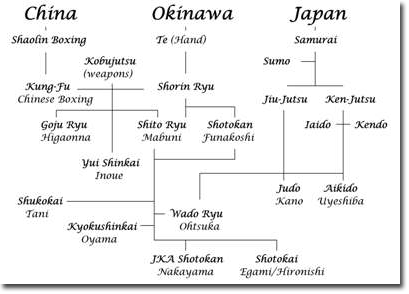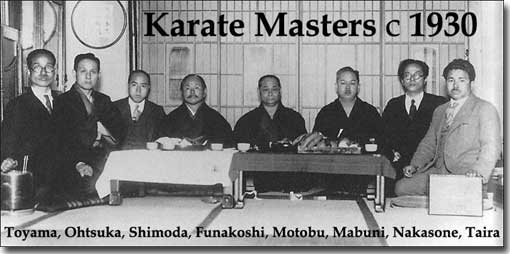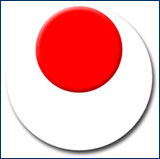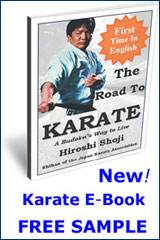|
History of Karate from Ancient Combat System to Modern Global Phenomenon
You don't need to know the full history of Karate leave that to the buffs. You need to understand the evolution of the eastern fighting arts no more than Picasso needed to know about Neanderthal cave art. The history of Karate is mildly interesting - but unnecessary.
A step by step account of what happened centuries ago between feuding warlords will do nothing for your progress - neither will legends of weaponless peasants defending themselves against armed attackers. Yet judging by the amount of stuff cut-and-pasted across the net, you would think a knowledge of martial arts history was mandatory for all Karateka. There will come a point in your Karate journey though, where curiosity will lead you to the historical record. When this happens turn up your BS filter because what you read was likely written a long time after it happened - by people who weren’t there!
Separating myth from fact is tricky but beyond the speculation you will find first hand material like the autobiography of Gichin Funakoshi the Okinawan who introduced Karate to Japan “Karate-do My Way of Life” (Kodansha). Worth a look, but don’t expect more than a good story. We know that the seeds of modern day Karate came from China and were sown in the former Ryukyu kingdom - now the southern islands of Japan. Exactly how and when is unknown. If you want hard evidence, collections of documents and artifacts exist in places like the Okinawan Karate museum. The museum displays local and Chinese training implements and weaponry - it is probably the most significant living record of the history of Karate anywhere in the world - a ‘must visit’ for serious researchers. Misconceptions about the History of Karate... Ancient Art? - It’s not. Unless you call less than a hundred years ancient. Can you believe baseball is older! Original Japanese Art? - Incorrect. Karate is a newbie in martial arts history - still considered by some as an imposter. Devised by one man? - Wrong. The history of Karate spans many generations - with contributions from many masters. Related to Jiu-jitsu? - No. Jiu-jitsu has an entirely different lineage pre-dating Japanese Karate by about 1000 years. Before 1868 Karate can trace its roots back to the early combat systems of China and probably further back in martial arts history to ancient India. But there’s nothing special about that. Human beings have disagreed and fought with each other since the dawn of time - stories of individual and group conflict appear in the oral and written records of every known civilization.
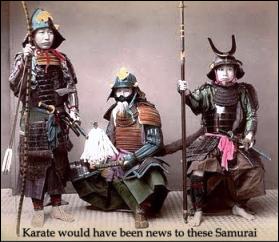
Japan’s oldest known book, the 8th century ‘Kojiki’ meaning "record of ancient matters" refers to combat systems and the ‘ways of war’. In particular it speaks about the warrior’s admiration for the sword. But we can skip the early records because Japanese Karate came much later. It evolved separately to archery, swordsmanship, wrestling and other original forms. It has no roots in mainland Japan. In the sixteenth century various conflicts gave rise to organized fighting with swords (which had already existed in Japan for more than a thousand years) spears, bows and arrows and grappling - collectively called Bu-jitsu. Later these ‘techniques’ were stylized and became known as Bu-gei (martial arts). At this time military dictators called Shogun (commanders of force) and hereditary nobles (Samurai) ruled. The Samurai were professional soldiers who lived by a code called Bushido (way of the warrior) a set of ethical and moral rules of loyalty for the shogun or emperor. Medieval knights lived by a similar code of honor - Chivalry. Towards the end of the last feudal period (1603-1868) peace prevailed in mainland Japan and martial arts were practiced in traditional schools called Koryu. The only uniquely Japanese unarmed striking art around at this time was Jiu-jitsu. As yet there was no history of Karate - it was unheard of.
Regular people joined former Samurai to study the martial arts and the whole approach to Kei-ko (practice) became formalized. In 1899, starting with Judo (gentle way) and then Kendo (way of the sword) in 1927, national organizations emerged with rules so that ‘players’ could compete against each other in a test of skills. In 1911, because of its inbuilt discipline, both of these arts under the general term ‘Budo’ became a compulsory part of school education. This lasted until 1945 and was probably a factor in the incredibly fast rebuilding of Japan after WW2.
Meanwhile the people of Okinawa in the Ryukyu archipelago of southern Japan had for some time practiced a weaponless form of hand and foot fighting introduced by merchants who made trading trips to Southern China. This only needed the use of bare fists, hands, elbows, feet, and knees. It was known among other things as “China-Hand” and “Okinawa-Hand”. These movements became organized into various schools (Ryu-ha) by masters who practiced for life, refining the techniques and passing their knowledge on - mostly through tight family lines.
Two main schools emerged from neighboring towns – Naha and Shuri. The suffix ‘Te’ was added to each, meaning ‘hand’, i.e. Naha-te and Shuri-te. From this tradition came a diminutive schoolteacher who would take things to a new level...
As a result of his life's efforts, Funakoshi later became known as the Father of Japanese Karate. Conditions were now perfect for Karate to expand. The people of post feudal Japan took easily to the austere training methods and added a new military dimension to it. Over time, Funakoshi’s core students introduced ideas of their own. Some remained loyal to the master’s teachings and others developed new techniques, philosophies and distinct ways of teaching. This was the beginning of Karate styles.
Karate never looked back. World War 2 stalled progress for a time, but as peace returned so did the Japanese appetite for anything that preserved the bruised national spirit. After the war four major Japanese Karate styles emerged - Funakoshi’s Shotokan (name taken from his ‘pen’ name) and 3 others Wado, Shito and Goju. These together with other uniquely Okinawan Karate styles, which had continued to develop and diversify, became the springboard for
Japanese Karate
to make a big leap forward... the biggest leap in the history of Karate... In 1970 the World Union of Karate-do Organizations formed to unify the art internationally. In 1990 the name changed to World Karate Federation (WKF). Okinawan Karate and Japanese Karate had opened their doors to the world and soon the west would make its mark. Karate is now a global phenomenon practiced by millions of people across all cultures. Well into the 21st century it remains true to Budo ideals while giving the world a fantastic sporting discipline. Top 5 Developments in the History of Karate... - Introduction of Okinawan Karate to Japan - Karate Becomes part of Education System in Japan - Emergence of Major Japanese Karate Styles - Founding of Japan Karate Association - Global expansion by JKA, WKF and others |





